Abstract
It was previously shown that uroporphyrinogen oxidation is catalysed by a form of cytochrome P-450 induced by 3-methylcholanthrene [Sinclair, Lambrecht & Sinclair (1987) Biochem. Biophys. Res. Commun. 146, 1324-1329]. We have now measured uroporphyrinogen oxidation and uroporphyrinogen decarboxylation simultaneously in 10,000 g supernatants from the livers of methylcholanthrene-treated mice and chick embryos incubated with an NADPH-generating system. We found that uroporphyrinogen oxidation is associated with inhibition of uroporphyrinogen decarboxylase activity. The decreased uroporphyrinogen decarboxylase activity was not due to depletion of substrate, since decarboxylase activity was not increased by a 2.6-fold increase in uroporphyrinogen. Uroporphyrinogen oxidation and the associated inhibition of decarboxylase activity were also observed with liver supernatant from methylcholanthrene-treated chick embryo; both actions required the addition of 3,3',4,4'-tetrachlorobiphenyl. Uroporphyrinogen oxidation catalysed by microsomes from a methylcholanthrene-treated mouse inhibited the uroporphyrinogen decarboxylase activity in the 100,000 g supernatant. Ketoconazole, an inhibitor of cytochrome P-450, prevented both uroporphyrinogen oxidation and the inhibition of uroporphyrinogen decarboxylation. The addition of ketoconazole to mouse supernatant actively oxidizing uroporphyrinogen inhibited the oxidation and restored decarboxylation. The latter finding suggested that a labile inhibitor was formed during the oxidation. These results suggest uroporphyrinogen oxidation may be important in the mechanism of chemically induced uroporphyria.
Full text
PDF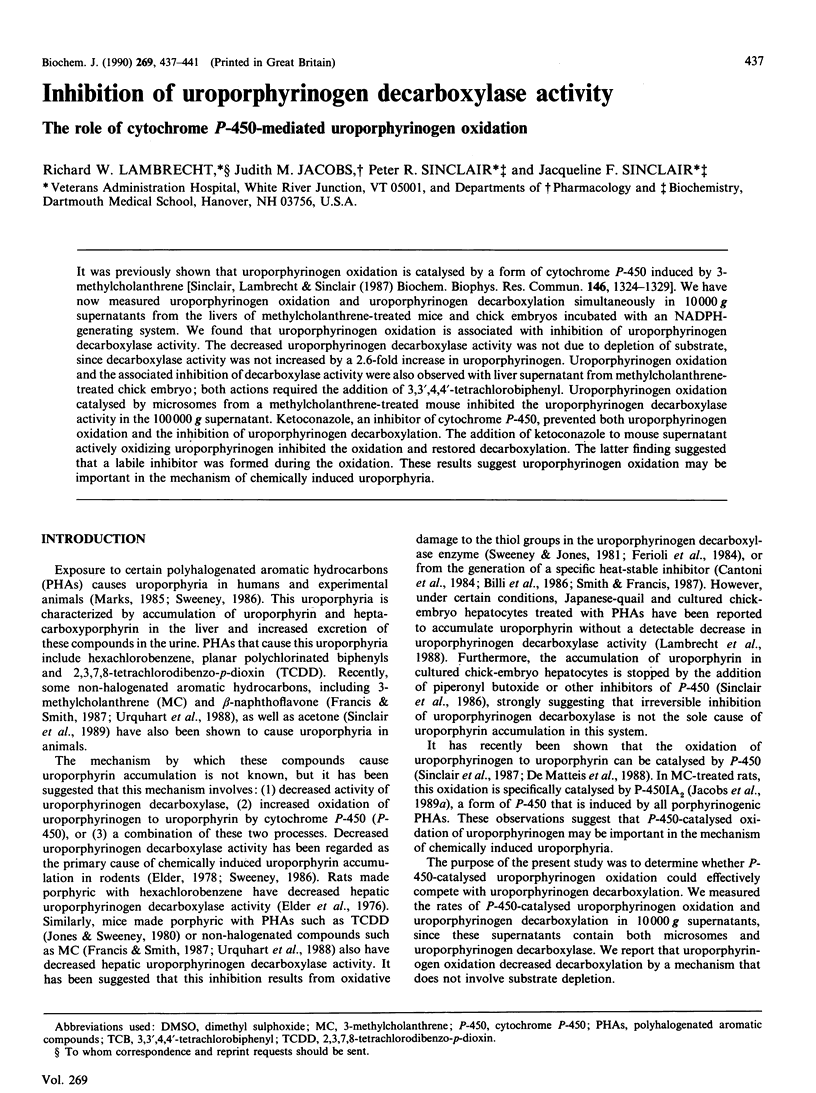
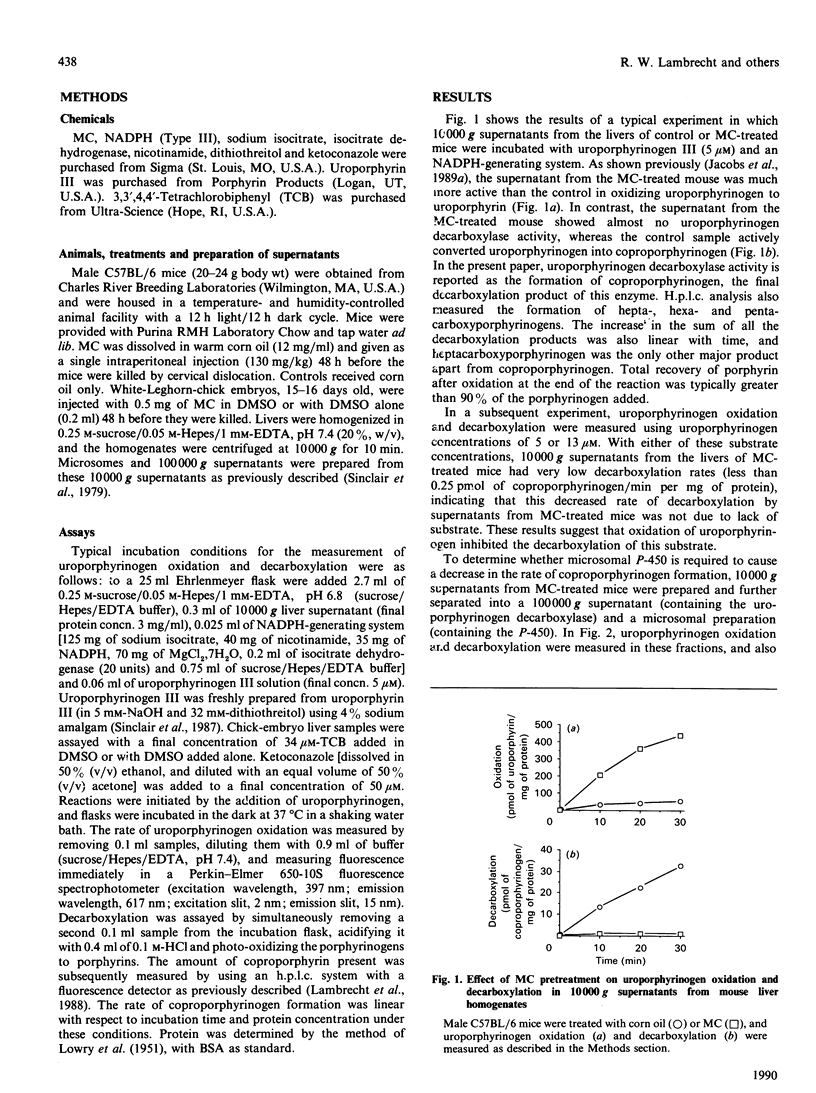
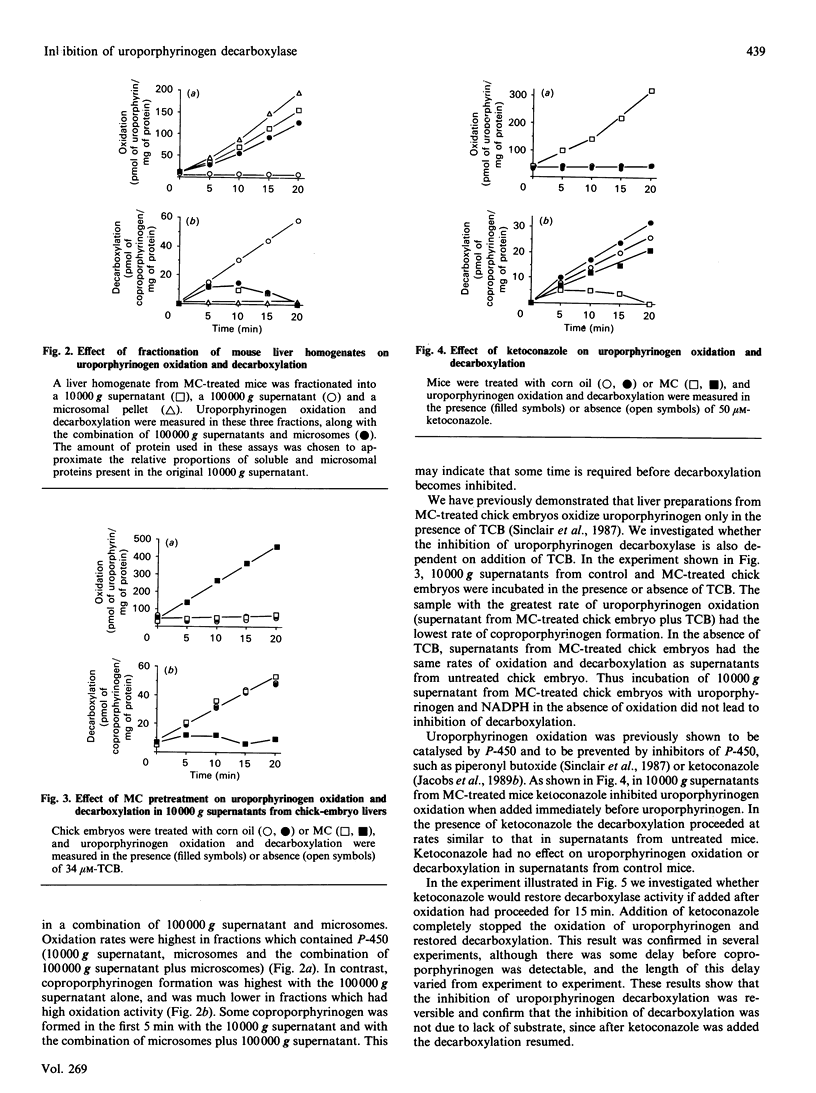
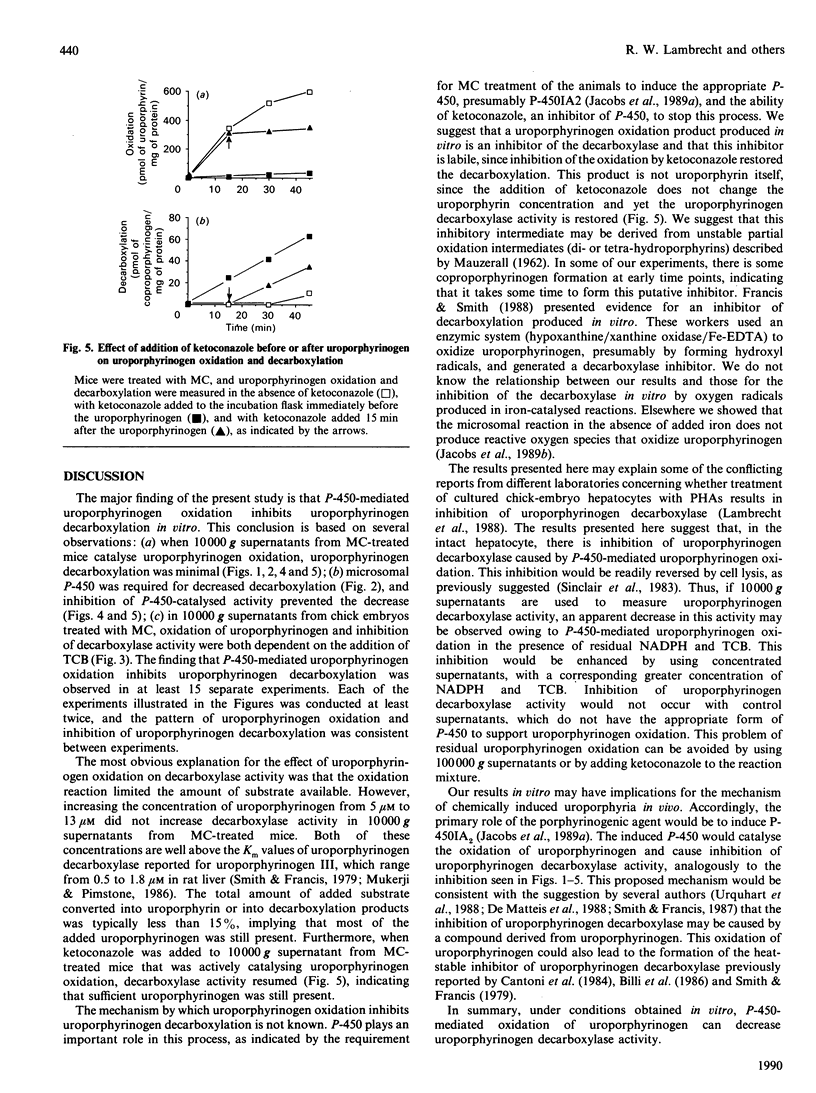
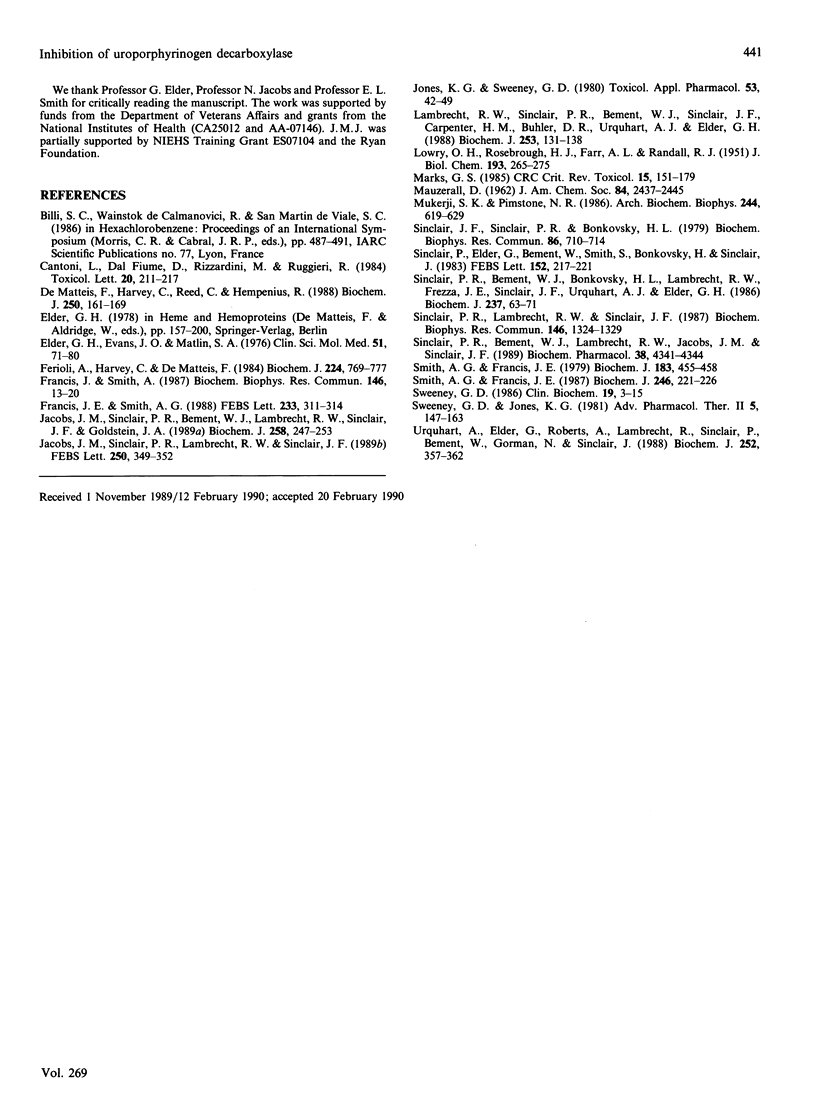
Selected References
These references are in PubMed. This may not be the complete list of references from this article.
- Billi S. C., Wainstok de Calmanovici R., San Martín de Viale L. C. Rat-liver porphyrinogen carboxy-lyase inhibition as a function of the degree of hexachlorobenzene-induced porphyria. IARC Sci Publ. 1986;(77):487–491. [PubMed] [Google Scholar]
- Cantoni L., dal Fiume D., Rizzardini M., Ruggieri R. In vitro inhibitory effect on porphyrinogen carboxylyase of liver extracts from TCDD treated mice. Toxicol Lett. 1984 Feb;20(2):211–217. doi: 10.1016/0378-4274(84)90149-8. [DOI] [PubMed] [Google Scholar]
- De Matteis F., Harvey C., Reed C., Hempenius R. Increased oxidation of uroporphyrinogen by an inducible liver microsomal system. Possible relevance to drug-induced uroporphyria. Biochem J. 1988 Feb 15;250(1):161–169. doi: 10.1042/bj2500161. [DOI] [PMC free article] [PubMed] [Google Scholar]
- Elder G. H., Evans J. O., Matlin S. A. The effect of the porphyrogenic compound, hexachlorobenzene, on the activity of hepatic uroporphyrinogen decarboxylase in the rat. Clin Sci Mol Med. 1976 Jul;51(1):71–80. doi: 10.1042/cs0510071. [DOI] [PubMed] [Google Scholar]
- Ferioli A., Harvey C., De Matteis F. Drug-induced accumulation of uroporphyrin in chicken hepatocyte cultures. Structural requirements for the effect and role of exogenous iron. Biochem J. 1984 Dec 15;224(3):769–777. doi: 10.1042/bj2240769. [DOI] [PMC free article] [PubMed] [Google Scholar]
- Francis J. E., Smith A. G. Oxidation of uroporphyrinogens by hydroxyl radicals. Evidence for nonporphyrin products as potential inhibitors of uroporphyrinogen decarboxylase. FEBS Lett. 1988 Jun 20;233(2):311–314. doi: 10.1016/0014-5793(88)80449-6. [DOI] [PubMed] [Google Scholar]
- Francis J. E., Smith A. G. Polycyclic aromatic hydrocarbons cause hepatic porphyria in iron-loaded C57BL/10 mice: comparison of uroporphyrinogen decarboxylase inhibition with induction of alkoxyphenoxazone dealkylations. Biochem Biophys Res Commun. 1987 Jul 15;146(1):13–20. doi: 10.1016/0006-291x(87)90683-8. [DOI] [PubMed] [Google Scholar]
- Jacobs J. M., Sinclair P. R., Bement W. J., Lambrecht R. W., Sinclair J. F., Goldstein J. A. Oxidation of uroporphyrinogen by methylcholanthrene-induced cytochrome P-450. Essential role of cytochrome P-450d. Biochem J. 1989 Feb 15;258(1):247–253. doi: 10.1042/bj2580247. [DOI] [PMC free article] [PubMed] [Google Scholar]
- Jacobs J. M., Sinclair P. R., Lambrecht R. W., Sinclair J. F. Effects of iron-EDTA on uroporphyrinogen oxidation by liver microsomes. FEBS Lett. 1989 Jul 3;250(2):349–352. doi: 10.1016/0014-5793(89)80753-7. [DOI] [PubMed] [Google Scholar]
- Jones K. G., Sweeney G. D. Dependence of the porphyrogenic effect of 2,3,7,8-tetrachlorodibenzo(p)dioxin upon inheritance of aryl hydrocarbon hydroxylase responsiveness. Toxicol Appl Pharmacol. 1980 Mar 30;53(1):42–49. doi: 10.1016/0041-008x(80)90379-8. [DOI] [PubMed] [Google Scholar]
- LOWRY O. H., ROSEBROUGH N. J., FARR A. L., RANDALL R. J. Protein measurement with the Folin phenol reagent. J Biol Chem. 1951 Nov;193(1):265–275. [PubMed] [Google Scholar]
- Lambrecht R. W., Sinclair P. R., Bement W. J., Sinclair J. F., Carpenter H. M., Buhler D. R., Urquhart A. J., Elder G. H. Hepatic uroporphyrin accumulation and uroporphyrinogen decarboxylase activity in cultured chick-embryo hepatocytes and in Japanese quail (Coturnix coturnix japonica) and mice treated with polyhalogenated aromatic compounds. Biochem J. 1988 Jul 1;253(1):131–138. doi: 10.1042/bj2530131. [DOI] [PMC free article] [PubMed] [Google Scholar]
- Marks G. S. Exposure to toxic agents: the heme biosynthetic pathway and hemoproteins as indicator. Crit Rev Toxicol. 1985;15(2):151–179. doi: 10.3109/10408448509029323. [DOI] [PubMed] [Google Scholar]
- Mukerji S. K., Pimstone N. R. In vitro studies of the mechanism of inhibition of rat liver uroporphyrinogen decarboxylase activity by ferrous iron under anaerobic conditions. Arch Biochem Biophys. 1986 Feb 1;244(2):619–629. doi: 10.1016/0003-9861(86)90630-2. [DOI] [PubMed] [Google Scholar]
- Sinclair J. F., Sinclair P. R., Bonkowsky H. L. Hormonal requirements for the induction of cytochrome P-450 in hepatocytes cultured in a serum-free medium. Biochem Biophys Res Commun. 1979 Feb 14;86(3):710–717. doi: 10.1016/0006-291x(79)91771-6. [DOI] [PubMed] [Google Scholar]
- Sinclair P. R., Bement W. J., Bonkovsky H. L., Lambrecht R. W., Frezza J. E., Sinclair J. F., Urquhart A. J., Elder G. H. Uroporphyrin accumulation produced by halogenated biphenyls in chick-embryo hepatocytes. Reversal of the accumulation by piperonyl butoxide. Biochem J. 1986 Jul 1;237(1):63–71. doi: 10.1042/bj2370063. [DOI] [PMC free article] [PubMed] [Google Scholar]
- Sinclair P. R., Bement W. J., Lambrecht R. W., Jacobs J. M., Sinclair J. F. Uroporphyria caused by acetone and 5-aminolevulinic acid in iron-loaded mice. Biochem Pharmacol. 1989 Dec 1;38(23):4341–4344. doi: 10.1016/0006-2952(89)90536-4. [DOI] [PubMed] [Google Scholar]
- Sinclair P. R., Elder G. H., Bement W. J., Smith S. G., Bonkowsky H. L., Sinclair J. F. Decreased activity of uroporphyrinogen decarboxylase caused by 2,4,5,3',4'-pentabromobiphenyl in chick embryo hepatocyte cultures. Difference in activity in intact or homogenized cells. FEBS Lett. 1983 Feb 21;152(2):217–221. doi: 10.1016/0014-5793(83)80383-4. [DOI] [PubMed] [Google Scholar]
- Sinclair P., Lambrecht R., Sinclair J. Evidence for cytochrome P450-mediated oxidation of uroporphyrinogen by cell-free liver extracts from chick embryos treated with 3-methylcholanthrene. Biochem Biophys Res Commun. 1987 Aug 14;146(3):1324–1329. doi: 10.1016/0006-291x(87)90794-7. [DOI] [PubMed] [Google Scholar]
- Smith A. G., Francis J. E. Chemically-induced formation of an inhibitor of hepatic uroporphyrinogen decarboxylase in inbred mice with iron overload. Biochem J. 1987 Aug 15;246(1):221–226. doi: 10.1042/bj2460221. [DOI] [PMC free article] [PubMed] [Google Scholar]
- Smith A. G., Francis J. E. Decarboxylation of porphyrinogens by rat liver uroporphyrinogen decarboxylase. Biochem J. 1979 Nov 1;183(2):455–458. doi: 10.1042/bj1830455. [DOI] [PMC free article] [PubMed] [Google Scholar]
- Sweeney G. D. Porphyria cutanea tarda, or the uroporphyrinogen decarboxylase deficiency diseases. Clin Biochem. 1986 Feb;19(1):3–15. doi: 10.1016/s0009-9120(86)80064-9. [DOI] [PubMed] [Google Scholar]
- Urquhart A. J., Elder G. H., Roberts A. G., Lambrecht R. W., Sinclair P. R., Bement W. J., Gorman N., Sinclair J. A. Uroporphyria produced in mice by 20-methylcholanthrene and 5-aminolaevulinic acid. Biochem J. 1988 Jul 15;253(2):357–362. doi: 10.1042/bj2530357. [DOI] [PMC free article] [PubMed] [Google Scholar]


